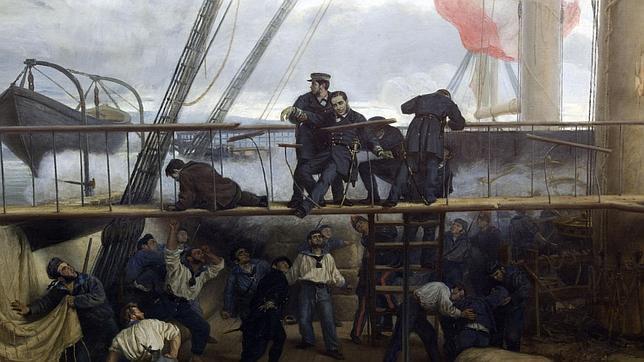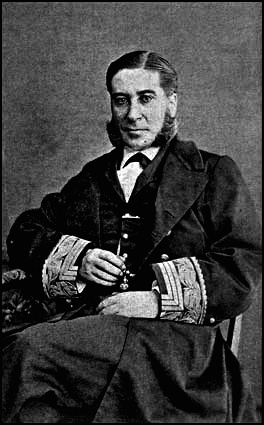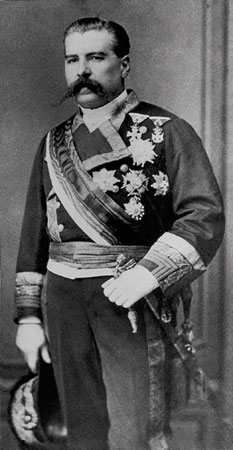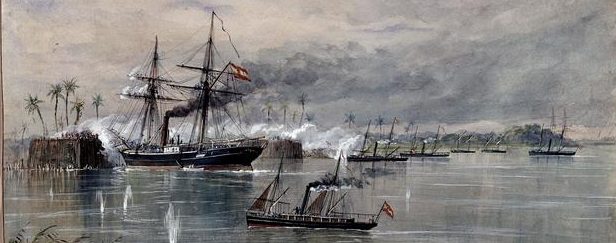Source:Espejo de navegantes
Last 2019, we commemorated the 150th anniversary of the death of a great Spanish sailor, Casto Méndez Núñez, whose expertise and honour made him stand out worldwide in his time, deserving the honors even from then model and hegemonic Royal Navy, represented by Admiral Sir William Montagu Dowell’s squad at his funeral service.
Méndez Núñez is especially remembered for his leading role in the “War of the Pacific”, which absurdly confronted Spain with two sister countries like Chile and Peru, distinguishing himself especially in the El Callao battle.

Méndez Nuñez wounded in the El Callao battle. Naval Museum of Madrid.
But long before he had shown his qualities, in a very different scenario: the secular fight against indigenous piracy in the Philippines.
One of the sources of piracy was on the great island of Mindanao, and well inland, with access to the sea through the “Rio Grande de Mindanao” (Mindanao River), which forced the attacker to endure a dangerous and problematic navigation through these fluvial waters. There the pirates built their base, in Pagalugán, in the “cotta” or fortification that gave it its name. It was a quadrangular fort, with walls seven meters high and six meters wide, more than enough to withstand any attempted assault and very capable of absorbing artillery fire, except the heaviest and most powerful, and finally, with a deep pit that made the assault impossible. Its garrison was of about 500 men, equipped with four large caliber pieces and others, more numerous and lighter: the “lantacas”. In addition, many others guarded the surroundings, a swampy mangrove with very difficult traffic.
Conquering such an enclave was going to be a very difficult mission, or even impossible. but it was decided to try it in 1861, with a combined expedition of the Army, which would provide the nucleus of the landing force, and the Navy, which would provide the ships for the amphibious operation.
The Army force was made up of the preferred companies, hunters and grenadiers, of the Philippine regiments “Príncipe” and “Infante”, together with a battery of four field guns and a section of workers, which was made up of indigenous people, except for the officers and a few non-commissioned officers. These soldiers were magnificent soldiers and, and highly motivated to fight against pirates. Colonel D. José Ferrater held the command.
That of the Navy consisted of the schooners “Constancia” and “Valiente”, of about 470 tons and two cannons, steam gunboats, of little more than 50 tons and a cannon: “Luzón nº 5”, “Arayat nº 12”. “Pampanga nº 13” and “Taal nº 18”, and the feluccas, rowing and sailing boats, numbers 1, 11, 13, 14, 36 and 37, also with European commanders and indigenous sailors. To transport the land expedition, three small merchants were mobilized, the “Scipión”, “Soledad” and “San Vicente”. The naval command was entrusted to the recently promoted Frigate Captain D. Casto Méndez Núñez. The respective commanders of the two schooners were Lieutenants José Malcampo and Zoilo Sánchez Ocaña.
Casto Méndez Núñez, a great sailor

Casto Méndez Núñez, a great sailor.
The expedition thus numbered about 850 men, distributed in the four companies mentioned, a battery and the workers’ section, the two schooners, four gunboats, and six feluccas, apart from the three merchant ships. The supreme command was Colonel Ferrater, due to his higher ranking.
After intimidating the fortress to surrender, at 4:30 am on November 17, the ships broke fire with their cannons against the fortress and the boats put the land force on land, ready to attack. But the resistance of the pirates was formidable, the fire extremely intense and the terrain impractical, while the casualties were mounting up without achieving anything.
Faced with the prospect of a complete disaster, Colonel Ferrater decided on a timely withdrawal, before things got worse, but Méndez Núñez, who had disembarked to acknowledge the situation, exclaimed a phrase that would become legendary: “The Navy does not withdraw!”
Nothing better than his own words by Méndez Núñez to narrate the events:
“… being in agreement with the Colonel of EM (Ferrater), I ordered him and the Infantry Commander D. Francisco Moscoso, who commanded the ground force after Commander García Carrillo’s injury, to be ready to scale the wall and, returning aboard the “Constancia”, I ordered all the available rifles to be placed on the crossbars, yards, and bowsprit, and her commander the order to march ahead and ram the cotta with the bow, at full throttle, which was verified with the greatest intelligence, and at a quarter past eight, with the greatest enthusiasm, shouting “Long live the Queen!”, the enemy fortress was boarded simultaneously by the sailors and troops on board the “Constancia” jumping over its walls and those on land. Then a hand-to-hand fight took place that lasted for a quarter of an hour, during which the ship lieutenant in charge of the assault force (Malcampo) was pierced from part to part by a bullet above the left nipple and took the Command of the navy force the ship’s ensign D. Pascual Cervera y Topete. At half-past eight the enemy began to flee from behind the cotta, but after dominating this space with the help of the colisa (rotating cannon) of the prow of the “Constancia”, a large number of casualties were caused by shrapnel and rifle fire. Shortly after we were in posesion of the fortress and the victorious Spanish flag waved over its walls, being greeted with the greatest enthusiasm by the troops of sea and land.”
José Malcampo

José Malcampo
Thus, in such a brave way was the amazing feat accomplished, a feat we believe unique in the Naval History of the World, in which a fortress was taken when boarding from a ship, achieving with that decision that that operation that already bordered on the disaster, turned into a great and unexpected triumph, with consequences of all kinds derived from it.
The casualties among the Spanish were sensitive: with 18 dead, 98 wounded and nine bruised. And among them commanders like Malcampo and Commander Moscoso. Almost all were produced by stab weapons, or by shrapnel fired by enemy cannons and lantacas, but few by individual firearms. The total represented around 14.7% of the expeditionary force, which proves the toughness of the fight.
With regard to the losses of the Navy, the “Constancia” that received 6 enemy impacts, counted one dead and six wounded, the “Valiente”, seven wounded and one bruised, 4 wounded the “Luzón”, who suffered several impacts and the breakdown of the machine, the “Arayat”, one dead and 5 wounded, the “Pampanga” one dead and six wounded and the “Taal” one dead and four wounded, the felucca numbers 14, 36 and 37, added three other wounded.
As for the pirates, about 110 corpses were collected in the cotta and another 26 in the surroundings, but given their habit of recovering them at all costs due to their Muslim religion, it was estimated that they must have been much more numerous, up to two hundred. Among them the Datto (main chief) Maghuda, and the first-born of another chief.
It was deemed inconvenient to garrison the fortress taken, so it was blown up with explosives and demolished completely, after which the expedition re-embarked and returned with the news of the sensational victory.
It should be noted that onboard the “Constancia” was not only Pascual Cervera and Topete but also the ship’s ensign , Patricio Montojo and Pasarón, who 37 years later commanded the squads that succumbed in Santiago de Cuba and Cavite.
Another curious detail was that those who approached the cotta from the “Constancia”, did so both by the bowsprit, the almost horizontal pole at the end of the bow and by planks that served as a catwalk between the ship and the walls, the schooner being at an angle of about 60º with the canvas of the wall, in an arrangement that curiously recalls the famous words of Cervantes in Don Quixote’s “Discourse of Arms and Letters”, recalling the battle of Lepanto.
Of course, the satisfaction for success in the face of tough and tenacious enemies, and even more so in the circumstances mentioned, was enormous. It and the consequences of the victory were joined by the confirmation of a naval leader as there have been few in any Navy in the world: Don Casto Méndez Núñez, who was promoted again the following year to Captain of the Navy for the success achieved and for the way it was achieved, adding two promotions in two consecutive years. And his professional career, as is well known, continued to show his qualities in every way, from courage to personal honesty.
That simple but firm phrase: “The Navy does not withdraw”, when its superior thought of abandoning the attack as impossible, will always figure among the greatest demonstrations of leadership, skill, and firmness.
Share this article
On This Day
No Events
History of Spain
26 August 2020
27 January 2021
Communism: Now and Then
23 December 2022
28 July 2021






